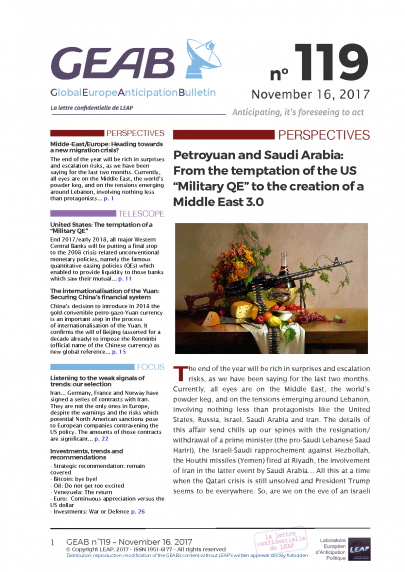GEAB 119
China’s decision to introduce in 2018 the gold-convertible petro-gazo-Yuan currency is an important step in the process of internationalisation of the Yuan. It confirms the will of Beijing (asserted for a decade already) to impose the Renminbi (official name of the Chinese currency) as new global reference currency. In October 2016 the IMF decided to introduce the Yuan into its own currency basket of the Special Drawing Rights (SDR), after a series of reforms and intense Chinese pressure. This was a very important step in this internationalisation process. The birth of the petroyuan, more than a year later, is another one.
The Chinese contradiction: the need to control AND liberalise
The Chinese government is accelerating this movement by enshrining it into a broader strategy. The signs, from this point of view, are quite visible. In August, Beijing’s government announced 22 corrective actions to open access to financial markets[1]. One month later, the report of the China Finance 40 Forum, which includes members of the central bank and of the People’s Bank of China (PBoC), called for further liberalisation of the Yuan market from then on[2]. At the beginning of October, Zhou Xiaochan, the governor of the PBoC for 15 years, on his way to leave office at the end of the year, pleaded for a “triple liberalisation”: that of capital, trade and the Yuan[3]. According to him, China shouldn’t wait for “the conditions to be ripe” to let the Yuan float freely. For the PBoC’s governance, China’s future economic development requires the internalisation of the Yuan in order to attract foreign capital. It would then be a boost to a growth which is actually fragile and artificially inflated by debt.
Login

The end of the year will be rich in surprises and escalation risks, as we have been saying for the last two months. Currently, all eyes are on the Middle [...]
End 2017/early 2018, all major Western Central Banks will be putting a final stop to the 2008 crisis-related unconventional monetary policies, namely the famous quantitative easing policies (QEs) which enabled [...]
- Iran ... Germany, France and Norway have signed a series of contracts with Iran. They are not the only ones in Europe, despite the warnings and the risks which [...]
Strategic recommendation: remain covered Even though this GEAB bulletin is optimistic and sees the end of the transition tunnel focused on peace in the Middle East, we shall keep our [...]

Comments